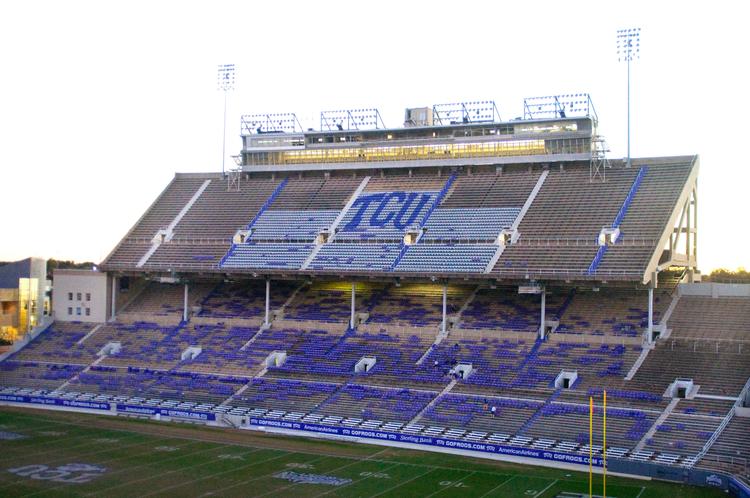Amon G. Carter Stadium: 80 years of history
Published Nov 16, 2010
In 1929, TCU went 9-0-1 and won the Southwest Conference title, starting talks that the team’s former home, Clark Field, was not big enough to hold the number of fans attending games. Construction to build Amon G. Carter Stadium started after the season.
In 2010, TCU is 11-0 and has clinched a share of the Mountain West Conference title. Talks began that the stadium did not match the quality of the product on the field, and a renovation project will start with a Dec. 5 implosion.
The two successful seasons at the stadium’s beginning and end mirror each other, and while its current form will soon disappear, Chancellor Victor Boschini said only the building would change.
“That stadium is always going to be called Amon G. Carter Stadium, at least as long as I’m alive, and I’m sure the next person will feel the same way,” he said.
Amon G. Carter Stadium opened on Oct. 11, 1930 with a 40-0 win over Arkansas in front of a then-capacity crowd of 22,000 fans. The stadium closed with another capacity crowd, this time of 45,694, who watched the Frogs beat San Diego State 40-35.
The 80-year-old stadium has seen Professional Football Hall of Famers Sam Baugh and Bob Lilly, Heisman Trophy winner Davey O’Brien and current NFL star LaDainian Tomlinson.
Although those four players were not at the stadium’s final game, hundreds of former lettermen took the field Saturday to say goodbye to “the Carter.” Baltimore Ravens linebacker Jason Phillips graduated in 2009 and said every player there Saturday played a role in the stadium’s legacy.
“It’s a good thing to look back at these guys that are back here,” Phillips said. “They built everything that we have right now, and for the young guys to continue that will be great.”
Jeff Ballard, quarterback in 2005 and 2006, said he would remember more than just individual games.
“[I’ll remember] the smell of the grass, the competition,” he said. “Just being a part of this whole day, this moment.”
Tenth-year head coach Gary Patterson said that even though he experienced games like last year’s beat down of Utah and Tomlinson’s 400-yard game in 1999, they are not what he would remember most about the stadium.
“I think more than the ballgames that stick out is just remembering the players,” he said. “The student-athletes, the kids that have played coming back, that I get phone calls from.”
Over the last 15 seasons, Amon G. Carter Stadium has undergone numerous renovation projects, including a new training facility, video board, administrative offices and luxury suites.
The $105 million renovation project will begin in less than a month, and Brian Estridge, the Frogs’ radio play-by-play voice, said there is a simple way to carry on the legacy of the stadium.
“The number one way to continue the legacy of Amon G. Carter Stadium is to continue to win and let it be that home-field advantage that it has become,” he said.
Since 1999, the Frogs are 62-6 at the stadium and will play host to Texas Tech and SMU next season and Virginia in 2012 to attempt to continue that home-field edge.
Amon G. Carter Stadium through the years:
Oct. 11, 1930
TCU 40, Arkansas 0
Amon G. Carter Stadium opened with a win. The Frogs went 9-2-1 in each of the Carter’s first two seasons before bringing the stadium its first conference title in 1932.
Nov. 30, 1935
SMU 20, TCU 14
In what sportswriter Grantland Rice called “The Game of the Century,” each team was ranked at the top of one of the polls in a game that ultimately pitted No. 1 against No. 2. A Southwest Conference title, Rose Bowl bid and national title were all on the line. Though the Mustangs won, they lost to Stanford in the Rose Bowl while TCU beat LSU in the Sugar Bowl, which is why each team claims the 1935 championship with one loss.
Oct. 15, 1955
No. 11 Texas A&M 19, No. 7 TCU 16
After Dutch Meyer moved into the role of athletic director at TCU, Abe Martin took over and led the Frogs to three Southwest Conference titles in his tenure. This match-up with Texas A&M was the highest-ranked match-up at the Carter Stadium in the Martin era. Martin is second on the all-time wins list at TCU with 145.
Nov. 17, 1984
No. 10 Texas 44, No. 12 TCU 23
The Frogs weren’t expected to do much in 1984. Coming off a 1-8 season and with a 3-8 season to follow in 1985, 1984 stands out as a kind of a miracle season for an overachieving group of Frogs led by running back Kenneth Davis. After moving into the Top 25 two weeks prior to the Texas game, TCU tallied back-to-back wins for the first time since 1979. But in front of a then-record crowd of 47,280, the miracle season ended at the hands of the Longhorns.
Nov. 20, 1999
TCU 52, UTEP 24
Toward the end of an otherwise average 8-4 season, LaDainian Tomlinson broke free against the Miners on his way to an NCAA-record 406 rushing yards. LT broke two runs of 60 yards or more and broke the 400-yard barrier on the last drive of the game with a seven-yard carry.
Nov. 14, 2009
No. 4 TCU 55, No. 16 Utah 28
In front of a national audience and the largest crowd in the history of Amon G. Carter Stadium, TCU put itself in serious contention for a BCS game. The Frogs piled up three straight touchdowns in the second quarter to take control.
Nov. 13, 2010
No. 3 TCU 40, San Diego State 35
In what was supposed to be a celebration of all things TCU, the Frogs stumbled to a five-point win over the Aztecs.






